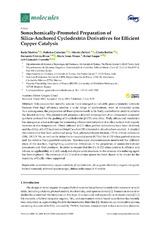Sonochemically-Promoted Preparation of Silica-Anchored Cyclodextrin Derivatives for Effcient Copper Catalysis
Autor
Martina, Katia
Calsolaro, Federica
Zuliani, Alessio
Berlier, Gloria
Chávez-Rivas, Fernando
Moran, Maria Jesus
Luque, Rafael
Cravotto, Giancarlo
Editor
MDPIFecha
2019Materia
SonochemistryCopper-catalysis
β-cyclodextrin
Silica
Green chemistry
Organic-inorganic hybrid materials
Infrared spectroscopy
Diffuse reflectance
UV-visible
METS:
Mostrar el registro METSPREMIS:
Mostrar el registro PREMISMetadatos
Mostrar el registro completo del ítemResumen
Silica-supported metallic species have emerged as valuable green-chemistry catalysts because their high efficiency enables a wide range of applications, even at industrial scales. As a consequence, the preparation of these systems needs to be finely controlled in order to achieve the desired activity. The present work presents a detailed investigation of an ultrasound-promoted synthetic protocol for the grafting of β-cyclodextrin (β-CD) onto silica. Truly, ultrasound irradiation has emerged as a fast technique for promoting efficient derivatization of a silica surface with organic moieties at low temperature. Three different β-CD silica-grafted derivatives have been obtained, and the ability of β-CD to direct and bind Cu when CD is bonded to silica has been studied. A detailed characterization has been performed using TGA, phenolphthalein titration, FT-IR, diffuse reflectance (DR), DR UV-Vis, as well as the inductively-coupled plasma (ICP) of the β-CD silica-grafted systems and the relative Cu-supported catalysts. Spectroscopic characterization monitored the different steps of the reaction, highlighting qualitative differences in the properties of amino-derivatized precursors and final products. In order to ensure that the Cu-β-CD silica catalyst is efficient and robust, its applicability in Cu(II)-catalyzed alkyne azide reactions in the absence of a reducing agent has been explored. The presence of β-CD and an amino spacer has been shown to be crucial for the reactivity of Cu(II), when supported.

